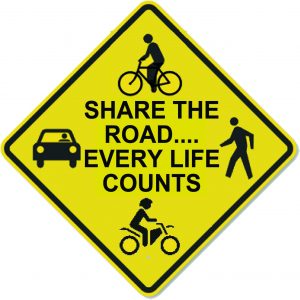Drivers, cyclists, and pedestrians –  We all use the roads and we’d each prefer to do so without the other in the way.
We all use the roads and we’d each prefer to do so without the other in the way.
Sometimes our own actions or the actions of others around us can put us in danger, especially when it comes to sharing the road. Although it is often unintentional, forgetting basic road etiquette can cause yourself or another harm and injury. Here are some safety tips that every motorist should know about sharing the roads:
- Drivers look for pedestrians when making turns, right? So why not take a couple extra seconds to look for a cyclist? The cyclist has the right of way if they are going straight and the driver is turning right.
- Pedestrians have responsibilities too. They should always avoid walking distracted. Keep earbud volume low enough to hear oncoming traffic and do not text and walk.
- If you are a driver approaching pedestrians and/or cyclists, wait to pass them until you have a clear view ahead and are sure there’s no oncoming traffic. A little bit of patience could save your life.
- Signal your turns and do it in plenty of time. Using turn signals is not only a law for drivers but for cyclists as well. By using hand signals to determine which way you are turning, this can alert drivers, other cyclists, and pedestrians when they see you coming.
When you’re behind the wheel of a vehicle, riding a bike or motorcycle, driving safely should always be your top concern. It’s crucial to know the basics of safe driving and practice them every time you’re on the road. This will ensure that everyone can travel and stay safe together.



 It’s a beautiful, sunny day and you just spent part of your day tossing tennis balls to your furry friend at the park. Heading home, you realize you need to pick up a few things from the supermarket; it should only take about five minutes. Sure, the sun is shining and it is about 80 degrees, but it will only be a few minutes, so there is no harm in leaving your friend in the car, right?
It’s a beautiful, sunny day and you just spent part of your day tossing tennis balls to your furry friend at the park. Heading home, you realize you need to pick up a few things from the supermarket; it should only take about five minutes. Sure, the sun is shining and it is about 80 degrees, but it will only be a few minutes, so there is no harm in leaving your friend in the car, right?





